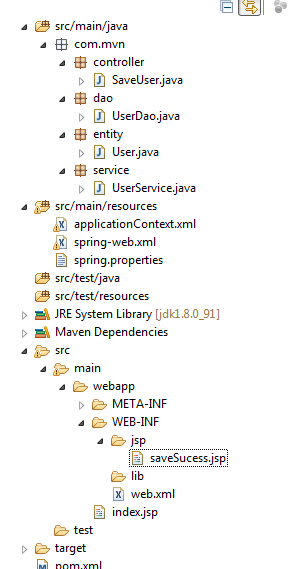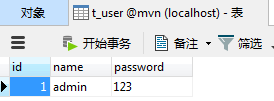The previous article used maven to build a web environment, which records how to use spring to integrate spring MVC and hibernate, that is, spring + spring MVC + Hibernate framework integration.
Step 1: configure spring first
- Configure the spring configuration file applicationContext.xmls
1 <?xml version="1.0" encoding="UTF-8"?> 2 <beans xmlns="http://www.springframework.org/schema/beans" 3 xmlns:xsi="http://www.w3.org/2001/XMLSchema-instance" xmlns:p="http://www.springframework.org/schema/p" 4 xmlns:context="http://www.springframework.org/schema/context" 5 xmlns:aop="http://www.springframework.org/schema/aop" xmlns:tx="http://www.springframework.org/schema/tx" 6 xmlns:mvc="http://www.springframework.org/schema/mvc" 7 xsi:schemaLocation="http://www.springframework.org/schema/beans 8 http://www.springframework.org/schema/beans/spring-beans-3.0.xsd 9 http://www.springframework.org/schema/context 10 http://www.springframework.org/schema/context/spring-context-3.0.xsd 11 http://www.springframework.org/schema/tx 12 http://www.springframework.org/schema/tx/spring-tx-3.0.xsd 13 http://www.springframework.org/schema/aop 14 http://www.springframework.org/schema/aop/spring-aop-3.0.xsd"> 15 <!-- Automatic scanning --> 16 <context:component-scan base-package="com.mvn" /> 17 <!-- Configuration automation aop --> 18 <aop:aspectj-autoproxy /> 19 20 </beans>
- Configure the web.xml file
<! -- configuration file to be read to configure spring context -- > <context-param> <param-name>contextConfigLocation</param-name> <param-value>classpath:applicationContext.xml</param-value> </context-param> <! -- configure spring listener to automatically initialize spring when the web container starts -- > <listener> <listener-class>org.springframework.web.context.ContextLoaderListener</listener-class> </listener>
Step 2: configure spring mvc
- Configure the spring mvc configuration file spring-web.xmls
1 <?xml version="1.0" encoding="UTF-8"?> 2 <beans xmlns="http://www.springframework.org/schema/beans" 3 xmlns:xsi="http://www.w3.org/2001/XMLSchema-instance" xmlns:p="http://www.springframework.org/schema/p" 4 xmlns:context="http://www.springframework.org/schema/context" 5 xmlns:aop="http://www.springframework.org/schema/aop" xmlns:tx="http://www.springframework.org/schema/tx" 6 xmlns:mvc="http://www.springframework.org/schema/mvc" 7 xsi:schemaLocation="http://www.springframework.org/schema/beans 8 http://www.springframework.org/schema/beans/spring-beans-3.0.xsd 9 http://www.springframework.org/schema/context 10 http://www.springframework.org/schema/context/spring-context-3.0.xsd 11 http://www.springframework.org/schema/tx 12 http://www.springframework.org/schema/tx/spring-tx-3.0.xsd 13 http://www.springframework.org/schema/aop 14 http://www.springframework.org/schema/aop/spring-aop-3.0.xsd 15 http://www.springframework.org/schema/mvc 16 http://www.springframework.org/schema/mvc/spring-mvc-3.0.xsd"> 17 <!-- Automatic scanning com.mvn.controller File, initializing the processor--> 18 <context:component-scan base-package="com.mvn.controller" /> 19 20 <!-- Configure the attempt parser (renderer) --> 21 <bean id="viewResolver" 22 class="org.springframework.web.servlet.view.UrlBasedViewResolver"> 23 <property name="viewClass" 24 value="org.springframework.web.servlet.view.JstlView" /> 25 <property name="prefix" value="WEB-INF/jsp/" /> 26 <property name="suffix" value=".jsp" /> 27 </bean> 28 29 </beans>
- Configure the web.xml file
1 <!-- To configure spring mvc Dispenser --> 2 <servlet> 3 <servlet-name>springmvc</servlet-name> 4 <servlet-class>org.springframework.web.servlet.DispatcherServlet</servlet-class> 5 <!-- Initialization spring mvc Location of profile --> 6 <init-param> 7 <param-name>contextConfigLocation</param-name> 8 <param-value>classpath:spring-web.xml</param-value> 9 </init-param> 10 <!-- web Load when container starts springmvc --> 11 <load-on-startup>1</load-on-startup> 12 </servlet> 13 14 <servlet-mapping> 15 <servlet-name>springmvc</servlet-name> 16 <url-pattern>*.do</url-pattern> 17 </servlet-mapping>
Step 3: configure hibernate
- Put hibernate related configuration into the spring configuration file applicationContext.xml
<!-- Auto read profile --> <context:property-placeholder location="classpath:spring.properties" /> <!-- Configure data sources --> <bean id="dataSource" class="org.apache.commons.dbcp2.BasicDataSource" destroy-method="close"> <property name="driverClassName" value="${jdbc.driverClassName}" /> <property name="url" value="${jdbc.url}" /> <property name="username" value="${jdbc.username}" /> <property name="password" value="${jdbc.password}" /> </bean> <!-- To configure sessionFactory--> <bean id="sessionFactory" class="org.springframework.orm.hibernate3.annotation.AnnotationSessionFactoryBean"> <property name="dataSource" ref="dataSource"></property> <!-- hibernate Auto scan entity class--> <property name="packagesToScan"> <list> <value>com.mvn.entity</value> </list> </property> <!-- hibernate attribute --> <property name="hibernateProperties"> <value> hibernate.hbm2ddl.auto=${jdbc.hibernate.hbm2ddl.auto} hibernate.dialect=${jdbc.hibernate.dialect} hibernate.show_sql=${jdbc.hibernate.show_sql} </value> </property> </bean> <!-- Transaction manager --> <bean id="transactionManager" class="org.springframework.orm.hibernate3.HibernateTransactionManager"> <property name="sessionFactory" ref="sessionFactory" /> </bean> <tx:annotation-driven transaction-manager="transactionManager" />
- Because it needs to read the property file, it needs to add
1 jdbc.driverClassName=com.mysql.jdbc.Driver 2 jdbc.url=jdbc:mysql://localhost:3306/mvn 3 jdbc.username=root 4 jdbc.password=root 5 6 jdbc.hibernate.dialect=org.hibernate.dialect.MySQL5Dialect 7 jdbc.hibernate.show_sql=true 8 jdbc.hibernate.hbm2ddl.auto=update
Step 4: write the corresponding java and jsp code
- Create entity class
1 package com.mvn.entity; 2 3 import javax.persistence.Entity; 4 import javax.persistence.GeneratedValue; 5 import javax.persistence.Id; 6 import javax.persistence.Table; 7 8 @Entity 9 @Table(name="t_user") 10 public class User { 11 12 private Integer id; 13 private String name; 14 private String password; 15 16 @Id 17 @GeneratedValue 18 public Integer getId() { 19 return id; 20 } 21 public void setId(Integer id) { 22 this.id = id; 23 } 24 public String getName() { 25 return name; 26 } 27 public void setName(String name) { 28 this.name = name; 29 } 30 public String getPassword() { 31 return password; 32 } 33 public void setPassword(String password) { 34 this.password = password; 35 } 36 37 }
- Create dao class
1 package com.mvn.dao; 2 3 import javax.annotation.Resource; 4 5 import org.hibernate.SessionFactory; 6 import org.hibernate.classic.Session; 7 import org.springframework.stereotype.Repository; 8 9 import com.mvn.entity.User; 10 11 @Repository 12 public class UserDao { 13 14 @Resource 15 SessionFactory sessionFactory; 16 17 public void save(User user){ 18 Session session = sessionFactory.openSession(); 19 session.save(user); 20 21 } 22 }
- Create service class
1 package com.mvn.service; 2 3 import javax.annotation.Resource; 4 5 import org.springframework.stereotype.Service; 6 import org.springframework.transaction.annotation.Transactional; 7 8 import com.mvn.dao.UserDao; 9 import com.mvn.entity.User; 10 11 @Service 12 public class UserService { 13 @Resource 14 UserDao userDao; 15 16 @Transactional 17 public void save(User user){ 18 userDao.save(user); 19 } 20 21 }
- Create controller
1 package com.mvn.controller; 2 3 import javax.annotation.Resource; 4 5 import org.springframework.stereotype.Controller; 6 import org.springframework.web.bind.annotation.RequestMapping; 7 8 import com.mvn.entity.User; 9 import com.mvn.service.UserService; 10 11 @Controller 12 public class SaveUser { 13 14 @Resource 15 UserService userService; 16 17 @RequestMapping(value="/saveUser") 18 public String saveUser(User user){ 19 userService.save(user); 20 return "saveSucess"; 21 } 22 }
- Create JSP file: WEB-INF \ JSP \ savesupplies.jsp
1 <%@ page language="java" contentType="text/html; charset=UTF-8" 2 pageEncoding="UTF-8"%> 3 <!DOCTYPE html PUBLIC "-//W3C//DTD HTML 4.01 Transitional//EN" "http://www.w3.org/TR/html4/loose.dtd"> 4 <html> 5 <head> 6 <meta http-equiv="Content-Type" content="text/html; charset=UTF-8"> 7 <title>Insert title here</title> 8 </head> 9 <body> 10 Hello 11 Congratulations! 12 Integration success 13 </body> 14 </html>
Now that the code is finished, the complete directory structure is:

Step 5: Test
- Create database

- Start tomcat. Since we have configured the hibernate attribute hibernate.hbm2ddl.auto=update, the table t ﹐ user will be generated automatically after tomcat is started
- Access through page

4. Data generated by database

So far, the integration is completed.